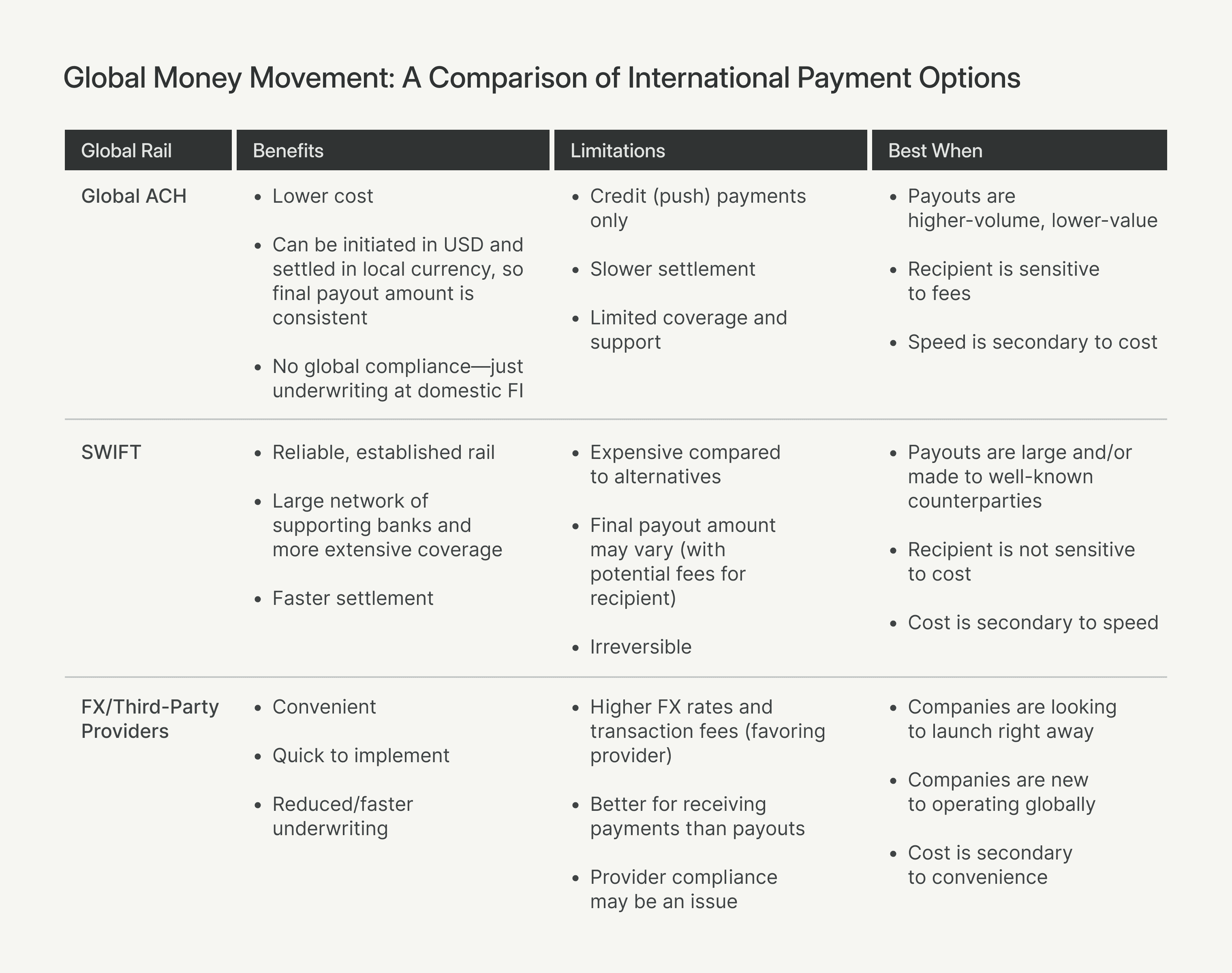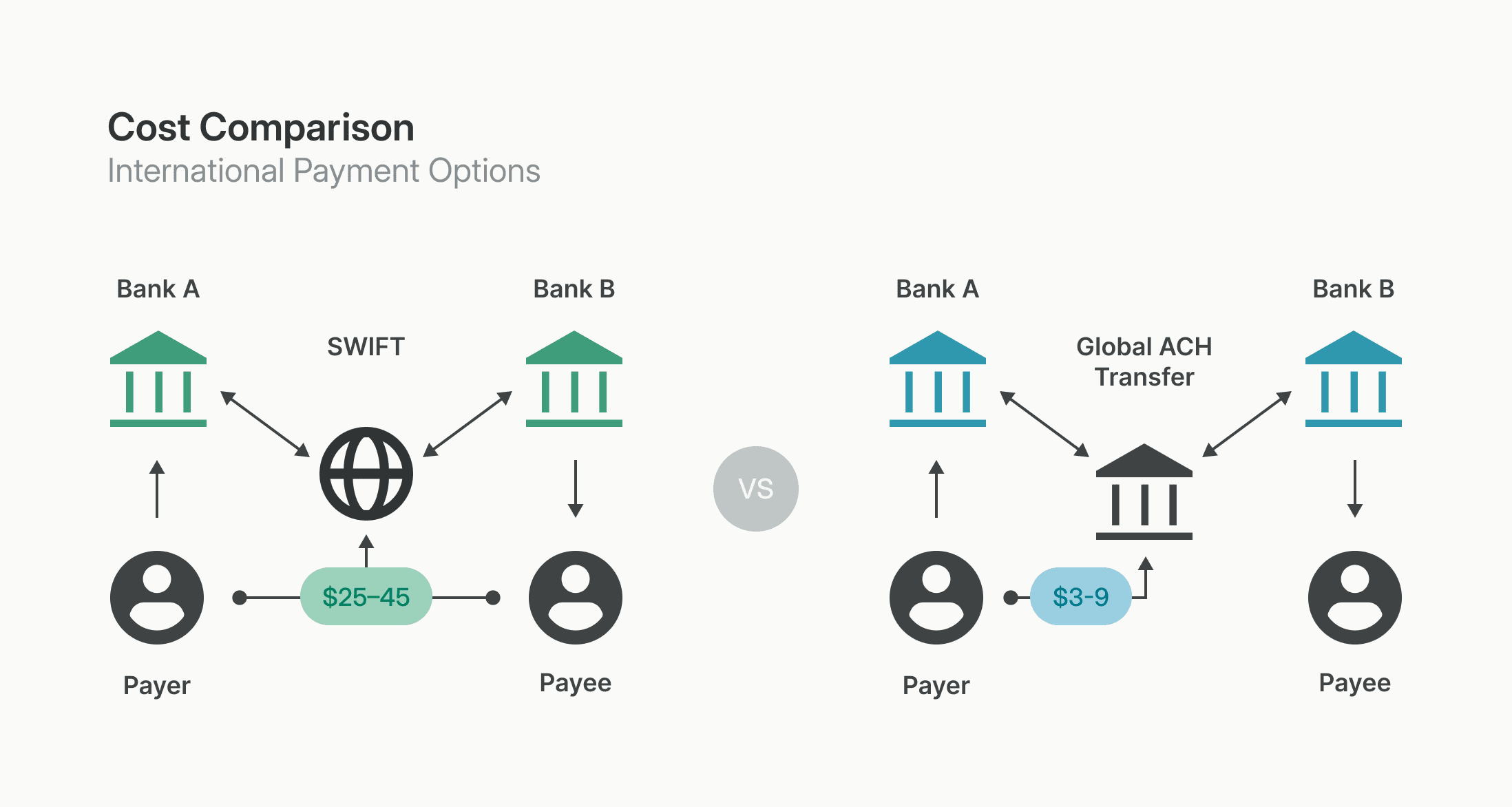Modern Treasury and Paxos Make It Easier for Businesses to Move Money with Stablecoins.Learn more →
Global ACH Part II: Streamlining International Payment Operations
In this second article in our series about Global ACH we detail how finance and operations teams can use this new rail to drive efficiency in global payment operations.

For finance and operations teams, we know that dealing with cross-border transactions can be a laborious, involved process—especially if you’re dealing with transactions in the thousands or millions. Global ACH is a newer option for finance and operations teams that can lower payments cost, increase internal efficiency, and operate leaner cross-border money flows. It’s particularly helpful for large companies managing a large amount of low-value payouts. Here in Part II of our Guide on Global ACH, we’ll walk you through some of the advantages of using Global ACH to expand your payment flows abroad.
Understanding Your Global Payment Options
There is a detailed discussion of the pros and cons of each of the three main options for cross-border payments in Part I of our Global ACH Series, so we won’t spend too much time covering it here. As a brief refresher, there are three main ways to move money internationally:
- Global ACH
- SWIFT
- Foreign Exchange (FX) provider/third-party processor

This article will look specifically at the benefits of implementing Global ACH for finance and operations teams, making comparisons to SWIFT and FX/third-party payment processors where relevant.
Streamlining Your International Payment Operations With Global ACH
Especially for larger companies dealing with a high volume of transactions, Global ACH can be a great option to streamline international payment operations and transactions. Below, we’ll look at each of its benefits—including cost, visibility, implementation, and reliability—in greater detail.
Optimize Your Cost Per Payment
For businesses that are looking to maximize their cost, Global ACH is the most cost effective way to move money cross-border. Typically between 5-7 times cheaper than sending a SWIFT transfer, Global ACH transactions can be variable in cost, depending on where you bank.

If you’re looking at sending a large amount of lower-value transactions, Global ACH is currently the most affordable option for cross-border transactions.
Start Sending Money To More Countries, More Quickly
Though it would simplify the process of sending international payments to host a bank account in all the countries where you need to make local payouts, the time and effort required to do so prevents it from being a truly scalable option for most businesses.
Underwriting, compliance, and adherence to local regulations are required for each account in each country, so if you need to send money to more than 1-2 countries outside of the US the workload to open and tend to these accounts can quickly become untenable. This makes Global ACH a better option for payout structures when you need a local presence in a variety of countries.
Though they can offer a faster launch initially, an FX Provider or a Third-Party Processor is not necessarily an effective long-term solution to the issue of sending cross-border payments, as they can come with the increased cost of paying for their services. There’s also the added operational burden of needing to manage liquidity with these third parties, versus with Global ACH, where the money is already in your bank account. These third parties also may not have the same high level of compliance that you can expect from a bank, which means customers may face downstream consequences by having to switch providers to ensure regulatory compliance. This can lead to issues that fall back on your business—potentially costing time, money, and resources in the long run.
And SWIFT, while historically a widespread option for sending cross-border payments, isn't necessarily easier to set up for a business looking to expand their international payment options either. Both sending and receiving financial institutions must be enrolled in SWIFT in order to make international payments between them—with Global ACH, only the sending financial institution needs to be equipped to make international payments using other countries’ ACH-equivalent rails.
In short, to use Global ACH to send international payments, all you need to do is choose a bank enabled to send Global ACH transfers—the system leverages local rails to do the rest.
Global ACH uses rails including EFT in Canada, SEPA in Europe, BACS in the UK, or BECS in Australia. If you want to set up a SWIFT transfer, however, you’ll need to both choose a US bank for your business that is set up to send SWIFT transfers and ensure that your payees are banking with SWIFT-eligible financial institutions in their respective countries as well.
Overall, Global ACH requires a slightly larger lift to implement than an FX Provider or a Third-Party Service Provider, but can be a more reliable way of sending international payments in long-term scenarios.
Give Payors Better Visibility Into Payments
Global ACH makes it possible for both sender and receiver to know exactly how much money will be transferred in any given transaction. In instances where a payment absolutely needs to be an exact amount, this is especially important.
For companies dealing with a high volume of international marketplace payouts—ClassPass, for example—predictable, on-time, and exact payouts are also imperative to their business model. If you have vendors on one side of a business, you need to ensure that you are paying them exactly what they are owed, when they are owed it— regardless of their location and currency.

Similarly, for situations like payroll—think of creators working internationally with Tik Tok, for example—companies can use Global ACH to ensure that their creators are receiving accurate payouts for their content.
Especially for higher volume, smaller dollar amount transactions—transactions in the thousands versus transactions in the millions—not only is Global ACH cheaper, but it is also significantly more reliable in allowing a company to deliver on a specific dollar amount to payees. This, in turn, leads to a happier experience for your employees, vendors, and other payees, lending another layer of trust and credibility to your business.
Increase Efficiency For Your Payment Ops Team with Modern Treasury
Another significant benefit of using Global ACH is its ability to streamline processes and increase efficiency for your internal payment operations team. With Global ACH, you won’t have to worry about reversals or returns in the same way as you do with traditional ACH payments. While possible, returns and reversals can be complicated, due to the nature of changing currencies during the transaction—which means that you need to have full confidence in a payment before sending it.
Using Global ACH can also remove some of the burden of compliance, too. Once you are underwritten by and banking with a bank that offers Global ACH, the cross-border compliance is managed by your bank. Instead of setting up multiple locally-domiciled accounts and learning and enforcing compliance rules and standards across several countries, you only need to understand and enforce compliance of your bank account.
Modern Treasury is an operations layer that can simplify and streamline your business’ access to all different types of payments. We can help your business implement Global ACH quickly and easily in 50+ currencies through our partnerships with banks like JP Morgan and Silicon Valley Bank. Plus, with Modern Treasury you can:
- Easily integrate with banks via a unified API
- Access automatic reconciliation on international payments
- Utilize instrumentation and developer tools without a per-transaction cost
- Gain total visibility into your global accounts, history of transactions, and balances across regions
And if SWIFT is truly a better option for your business? We can facilitate that for you, too. Get in touch with our sales team to find out how we can help your business move money faster and easier.








